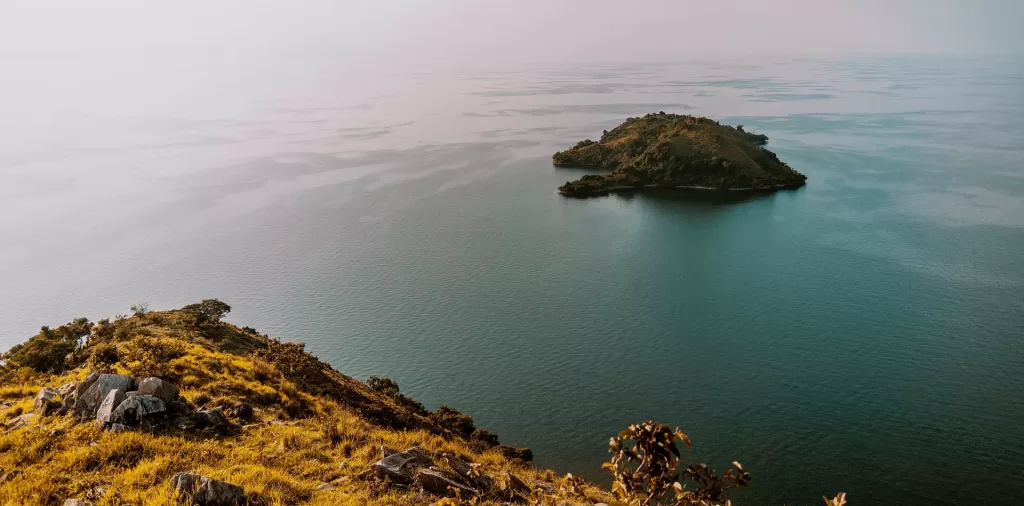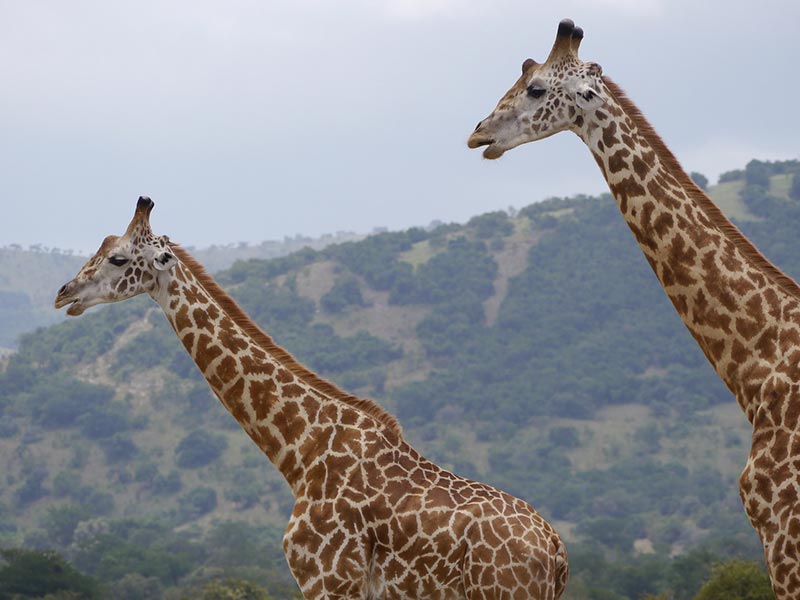Gishwati Mukura National Park
Gishwati Mukura National Park
Gishwati Mukura National Park
Gishwati Mukura National Park is a hidden treasure located in the heart of Rwanda. This pristine park covers the lush hills of the Western Province and includes the Gishwati and Mukura forests, two vital ecosystems that are rich in biodiversity and natural beauty.
Rwanda’s fourth national park, Gishwati Mukura, is made up of two separate forests – the larger Gishwati and smaller Mukura – which together cover a total area of 34 square kilometers, including a buffer zone.
The park is home to a troupe of 20 chimpanzees, as well as golden monkeys, L’Hoest’s monkeys, and blue monkeys. Additionally, there are almost 400 bird species in the park, with 232 bird species found in the Gishwati Forest and 163 bird species in the Mukura Forest.
Gishwati Mukura National Park is an example of Rwanda’s dedication to conservation and sustainable development. Efforts to restore and protect the park’s delicate ecosystems are ongoing, ensuring that future generations will be able to appreciate its beauty and biodiversity for years to come.
Top Things to Do in Gishwati -Mukura National Park
Chimpanzee trekking
Chimpanzee trekking is one of the most popular activities in the park as it offers an exceptional opportunity for visitors to connect with nature. Guests can explore the dense foliage of Gishwati and observe these intelligent primates in their natural habitat.
In addition to chimpanzees, the forest is home to various primate species such as playful golden monkeys, elusive Blue monkeys, dignified L’Hoest’s monkeys, and the ever-watchful baboons.
Hiking and Nature walks
For those who want to explore the Gishwati Mukura National Park’s natural wonders, there are several trails to choose from, each promising a unique adventure. The Waterfall Trail, which is four miles long, leads to the stunning Kazenenza waterfall, renowned for its scenic beauty. As water cascades down rocky cliffs, it forms a mesmerizing pool below, captivating visitors’ senses.
The Umushwati Trail is a five-mile-long path that takes visitors through the heart of the forest, offering an immersive experience amidst nature’s splendor. This trail can be pursued as an out-and-back route or used to connect with other park trails. It unveils the park’s hidden treasures at every turn, providing opportunities to witness Rwanda’s natural beauty at its finest.
The Matyazo Hill Trail is another trail worth exploring. It winds through lush greenery and diverse wildlife, providing panoramic vistas of the surrounding landscapes as visitors ascend. As you hike, keep your senses attuned to the forest’s sights and sounds, as unique flora and fauna reveal themselves along the way.
Birds watching in Gishwati Mukura National Park
Gishwati Mukura National Park is a fantastic spot for birders’ due to its diverse range of bird species. The park boasts over 235 recorded bird species, including some that are endangered and only found in the Albertine Rift.
The most coveted bird sighting in the park is the Rwenzori Blue Turaco, which is not only a symbol of the park’s rich biodiversity but also a testament to the conservation efforts in place.
As you explore the winding trails of Gishwati Mukura, keep your eyes peeled for a treasure trove of bird species waiting to be discovered. Among them, the Regal Sunbird stands out with its iridescent plumage, while the elusive Grauer’s swamp warbler is known for hiding among the reeds and adding a touch of mystery to your birding adventure. The Rwenzori Batis is another highlight, with its striking black and white plumage that is sure to catch your eye.
However, the avian wonders of Gishwati Mukura go far beyond these highlights. From the Purple-breasted Sunbird sipping nectar from delicate blossoms to the regal Martial Eagle soaring high above the canopy, each species adds its unique charm to the park’s rich tapestry of life.
Keep an eye out for the Strange Weaver crafting intricate nests with skillful precision, or the elegant Grey Crowned Crane dancing gracefully amidst the marshlands.
If you’re looking for rare and elusive sightings, Gishwati Mukura will not disappoint you. The Dusky Crimson wing, with its crimson plumage, is a testament to the park’s conservation efforts, while the melodious Red-throated Alethe adds a symphonic touch to the forest’s tranquil ambiance.
Cultural Encounters / Community-Based Tours
Cultural encounters in Gishwati Mukura National Park involve visits to the local communities or individual homesteads. Visitors can learn how to make local crafts and prepare traditional foods. You can choose to visit the local farmers in their gardens or stay for a night in one of the homes to experience the kind of life lived by the locals.
Alternatively, you can choose to go and attend local cultural performances including dance, drama, songs, and storytelling. If you are more adventurous, you could visit one of the traditional healers and learn how herbs are collected from the forests to cure common human ailments.
The Great Ape Trust has partners with the Rwanda Development Board to support cultural dances, and drama to promote local art.
Biking or cycling via the Congo Nile Basin
Embark on an exhilarating biking adventure through Gishwati Mukura National Park along the iconic Congo Nile Trail. This renowned trail offers cyclists an unforgettable journey through the heart of Rwanda’s breathtaking landscapes, combining adventure with cultural immersion.
The Congo Nile Trail is designed to provide a thrilling experience. It winds its way from the shores of Lake Kivu, offering panoramic views of this majestic body of water, before meandering through lush forests and rural Rwandan villages.
As cyclists pedal along the trail, they have the opportunity to immerse themselves in the rich culture and heritage of the region. They can interact with local communities and witness daily life unfold.
Adjacent to Gishwati Mukura National Park, the Congo Nile basin serves as the perfect gateway for travelers eager to explore the natural wonders of rural Rwanda. The trail offers a glimpse into the diverse landscapes and vibrant traditions that define this corner of Africa.
From dense forests teeming with wildlife to picturesque villages nestled amidst rolling hills, the trail is a journey through Rwanda’s captivating beauty and timeless charm.
The Congo Nile Trail is perfect for both seasoned cyclists seeking adventure and leisure riders craving cultural experiences. So hop on your bike, breathe in the fresh air, and let the wonders of Gishwati Mukura National Park and the Congo Nile basin unfold before you.
Where to Stay in Gishwati Mukura National Park
Forest of Hope Guest House and Camp Site.
The guest house consists of two en-suite rooms. Both have two twin beds, mosquito nets, hot water, electricity, WiFi, and a private terrace with sweeping forest views.
The campsite is unserved and only suitable for self-catering guests. Toilet and shower facilities, a small fireplace, a barbeque stand, and water for cleaning and cooking are available. Laundry is available on request at an additional fee.
How to get to Gishwati Mukura National Park
From Rubavu. follow the road through Kivu-Goma-Karongi-Rusizi-then Gishwati Makura National Park. This will take 2 hours drive. The distance from Kigali to Gishwati Mukura Park is about a 2-3 hour journey covering 85km. A chartered flight to the park takes only 45 minutes.
When to visit Gishwati Mukura National Park
Gishwati Mukura National Park boasts two temperate wet seasons and two dry seasons all the year-round. The best time to visit Gishwati Mukura National Park is during the dry season in December – February and June – September. The dry periods present favorable conditions for chimp trekking, hiking, birding, and nature walks, among others.
During dry seasons, the trails in the Gishwati Mukura National Park are not slippery as compared to the wet seasons.
The wet season is characterized as long and short wet seasons. March-May is the long-wet season, and the short-wet season is experienced from October – November.
Best Time to Visit the Park
The best time to visit Rwanda depends on what you want to experience. Generally, the dry seasons from June to September and from December to February are considered the best times for gorilla trekking and other wildlife viewing in national parks like Volcanoes National Park and Akagera National Park.
During these months, the weather is usually dry and the skies clear, making it easier to navigate through the parks and spot wildlife.
However, Rwanda’s climate is relatively mild and temperate year-round due to its elevation, so even during the rainy seasons (March to May and October to November), travel is still possible.
The rainy season can offer lush green landscapes and fewer tourists, which might be appealing if you prefer a quieter experience.
Rwanda Safari Destinations
ABOUT TRAVELERS LINK AFRICA
Our mission at Travelers Link Africa is to connect people to positive travel experiences enabling them to see the world differently, transforming lives and the communities visited.
To do this we offer authentic travel experiences taking you on both an outer adventure and an inner journey to create memories of a lifetime with Uganda, Kenya, Tanzania, and Rwanda
GET SOCIAL WITH US
Follow our Travelers Link Africa adventures and share your own with us
CONNECT WITH US
We’re here to help, so get in touch with our friendly travel consultants to book your package or add customizations your safari
Our main phone number is
+256 754 062 366
– OR –




